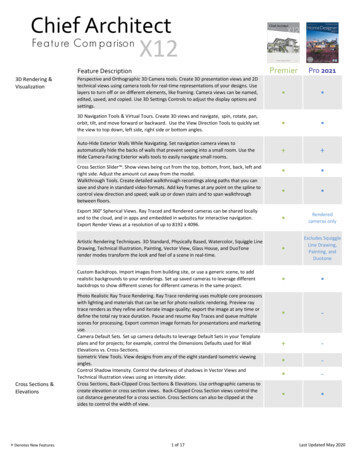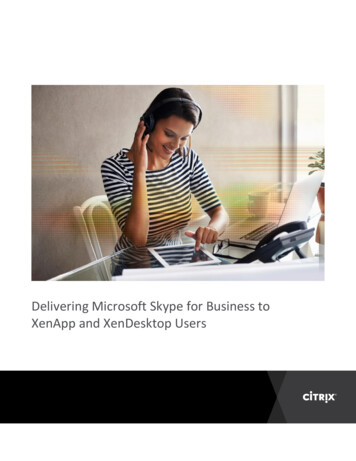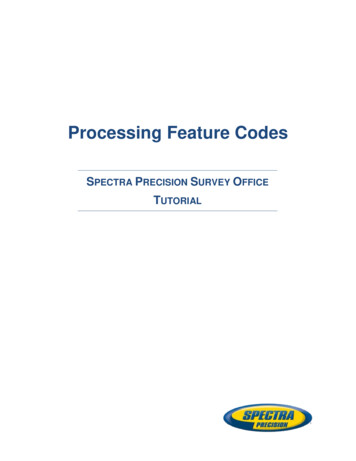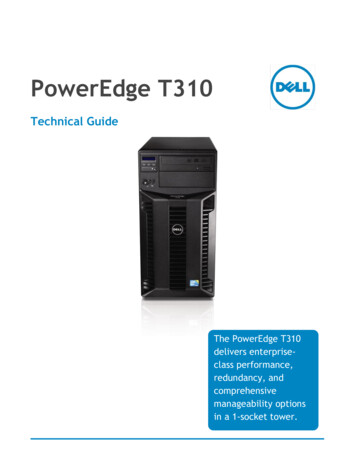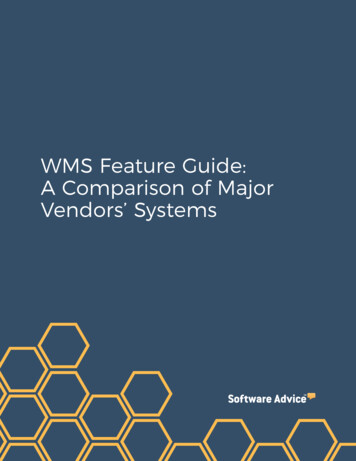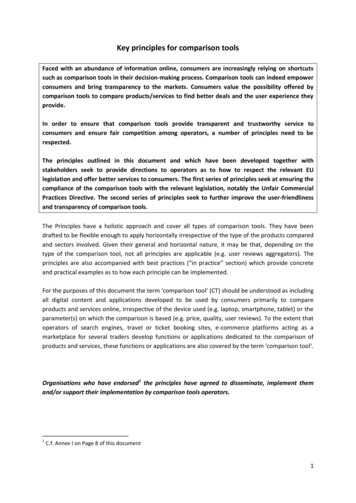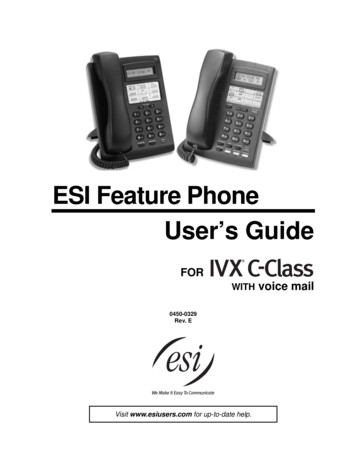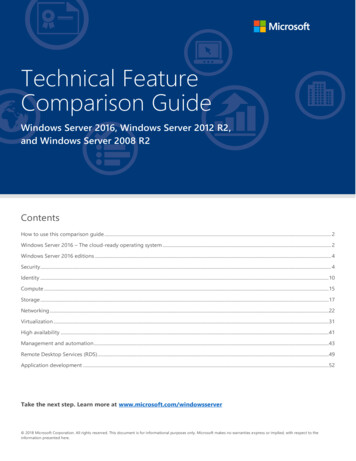
Transcription
Technical FeatureComparison GuideWindows Server 2016, Windows Server 2012 R2,and Windows Server 2008 R2ContentsHow to use this comparison guide . 2Windows Server 2016 – The cloud-ready operating system . 2Windows Server 2016 editions . 4Security . 4Identity .10Compute .15Storage .17Networking .22Virtualization .31High availability .41Management and automation .43Remote Desktop Services (RDS) .49Application development .52Take the next step. Learn more at www.microsoft.com/windowsserver 2018 Microsoft Corporation. All rights reserved. This document is for informational purposes only. Microsoft makes no warranties express or implied, with respect to theinformation presented here.
How to use this comparison guideThis feature comparison guide compares selected features of Microsoft Windows Server 2008 R2, Windows Server 2012 R2, andWindows Server 2016. Its goal is to help customers understand the differences between the version they are running today andthe latest version available from Microsoft.Customers who are innovating quickly can move to the Semi-annual Channel licensing model to get more frequent featurereleases for Windows Server. This guide does not currently include details about the new semi-annual releases, but you canfind more details here.The comparison table includes comments about each feature, as well as notation about how well each feature is supported ineach release. The legend for this notation is given in the table below.Level of feature supportFeature ature descriptionWindows Server 2016 – The cloud-ready operating systemWindows Server 2016 is the cloud-ready operating system that delivers new layers of security and Azure-inspired innovation forthe applications and infrastructure that power your business. Increase security and reduce business risk with multiple layers ofprotection built into the operating system. Evolve your datacenter to save money and gain flexibility with software-defineddatacenter technologies inspired by Microsoft Azure. Innovate faster with an application platform optimized for the applicationsyou run today as well as the cloud-native apps of tomorrow.Easier hybrid cloud computingWindows Server 2016 is designed to work well for hybrid environments: Benefit from cloud-consistency built into Windows Server 2016 to move workloads from on-premises to the cloud, invirtual machines (VMs) or containers. Use familiar management skills and tools, including PowerShell, to manage across your on-premises, hosted, or publiccloud environments. Use your on-premises Windows Server licenses with Software Assurance to save up to 49 percent when you moveworkloads to Azure with the Azure Hybrid Benefit. Find out more at www.azure.com/ahub.Built-in securityWindows Server 2016 includes built-in breach resistance to help thwart attacks on your systems and meet compliance goals. Evenif someone finds a way into your environment, the layers of security built into Windows Server 2016 limit the damage they cancause and help detect suspicious activity. Help prevent risks associated with compromised administrative credentials. Use new privileged identity managementfeatures to limit administrative access by enabling “just enough” and “just-in-time” administration capabilities. UseCredential Guard to prevent administrative credentials from being stolen by Pass-the-Hash attacks. Protect your virtual machines using the unique Shielded Virtual Machine feature. A Shielded VM is encrypted usingBitLocker and can only run on approved hosts. Protect against unknown vulnerabilities by ensuring only permitted binaries are executed using additional securityfeatures such as Control Flow Guard and Code Integrity as well as Windows Defender optimized for server roles. Use Hyper-V isolation for a unique additional layer of isolation for Windows and Linux containerized applications.Windows Server 2016 Technical Feature Comparison Guide – Page 2
Software-defined infrastructureDatacenter operations are struggling to reduce costs while handling more data traffic. New applications stretch the operationalfabric and create infrastructure backlogs that can slow business. Windows Server 2016 delivers a more flexible and cost-efficientoperating system for datacenters, using software-defined compute, storage, and network virtualization features inspired by Azure.Resilient computeRun your datacenter with a highly automated, resilient, virtualized server operating system. Upgrade infrastructure clusters to Windows Server 2016 with zero downtime for your Hyper-V or scale-out file serverworkloads, and without requiring new hardware, using Mixed OS Mode cluster upgrades. Increase application availability with improved cluster resiliency to transient failures in network and storage. Automate server management with PowerShell 5.1 and Desired State Configuration. Deploy applications on multiple operating systems with best-in-class support for Linux on Hyper-V. Control Windows servers from anywhere using Microsoft Management Console or Server Manager, both of which can beused remotelyReduced-cost storageWindows Server 2016 includes expanded capabilities in software-defined storage with an emphasis on resilience, reduced cost,and increased control. Build highly available and scalable software-defined storage solutions at a fraction of the cost of SAN or NAS. StorageSpaces Direct uses standard servers with local storage to create converged or hyper-converged storage architectures. Create affordable business continuity and disaster recovery among datacenters with Storage Replica synchronousstorage replication. Ensure application users have priority access to storage resources using Quality-of-Service features.Agile networkingWindows Server 2016 delivers key networking features inspired by technology in the Azure datacenters to support agility,dynamic security, and hybrid flexibility in your datacenter. Deploy and manage workloads with different types of networking policies (isolation, Quality of Service, security, loadbalancing, switching, routing, gateway, DNS, etc.) across their entire lifecycle in a matter of seconds using a scalableNetwork Controller. Dynamically segment your network based on workload needs using a distributed firewall and network security groups toapply NIC and subnet in enforcement by routing or mirroring traffic to virtualized firewall appliances for even greaterlevels of security. Take control of your hybrid workloads and move them across servers, racks, and clouds using standards-based VXLANand NVGRE overlay networks and multi-tenanted hybrid gateways. Optimize cost/performance by converging RDMA storage traffic and tenant workload traffic on the same teamed NICs,thereby driving down cost while providing performance and Quality of Service (QoS) at 40G and beyond.Cloud-ready application platformWindows Server 2016 delivers new ways to deploy and run your applications – whether on-premises, in a hybrid environment, orin any public cloud or hosted environment – using capabilities such as Windows Server containers and Nano Server as thecontainer image. Build cloud-native and hybrid apps using containers and microservices architectures. Move your traditional applications into a modern DevOps environment with little or no code changes using containers.Windows Server Containers bring the agility and density of containers to the Windows ecosystem, enabling agileapplication development and management. Use Hyper-V isolation for a unique additional level of security for Linux andWindows containerized applications without any changes to the container image. Use Active Directory identity mappedto your Windows Server Containers. Microsoft, Docker Inc. and the Docker Community have partnered to provide the Docker Enterprise Edition with supportfor new container technologies in Windows Server 2016. Use Nano Server as the container image for the agility and flexibility today’s application developers need. Optimized foruse inside containers, it’s the perfect option for working with microservices. Run traditional first-party applications such as SQL Server 2016 with best-in-class performance, security and availability.Windows Server 2016 Technical Feature Comparison Guide – Page 3
Windows Server 2016 editionsWindows Server 2016 editions include: Datacenter: This edition delivers significant value for customers who need unlimited virtualization along with powerfulnew features including Shielded Virtual Machines, software-defined storage and software-defined networking. Standard: This edition is ideal for customers who need limited virtualization but require a robust, general purpose serveroperating system. Essentials: This edition is designed for small-to-medium sized customers with 25-50 users.Windows Server 2016 will not have a Foundation edition, but current Foundation customers will find the Essentials edition to be aclose match for their requirements.For the Standard and Datacenter editions, there are two installation options: Server Core: The Server Core installation option removes the client UI from the server, providing an installation that runsthe majority of the roles and features on a lighter install. Server Core does not include Microsoft Management Console(MMC) or Server Manager, which can be used remotely, but does include limited local graphical tools such as TaskManager as well as PowerShell for local or remote management.Server with Desktop Experience: The Server with Desktop Experience installation option provides an ideal userexperience for those that need to run an app that requires local UI or for Remote Desktop Services Host. This option hasthe full Windows client shell and experience, consistent with Windows 10 Anniversary edition Long Term ServicingBranch (LTSB), with the MMC available locally on the server.SecurityWindows Server 2016 delivers layers of protection that help address emerging threats and meet your compliance needs, makingWindows Server 2016 an active participant in your security defenses. These include the new Shielded Virtual Machine feature thatprotects VMs from attacks and compromised administrators in the underlying fabric, extensive threat resistance components builtinto the Windows Server 2016 operating system and enhanced auditing events that will help security systems detect maliciousactivity.Shielded Virtual MachinesWindows ServerWindows ServerWindows Server2008 R22012 R22016Shielded Virtual Machines and Guarded Fabric help provide hosting service providers and private cloud operators theability to offer their tenants a hosted environment where protection of tenant virtual machine data is strengthened againstthreats from compromised storage, network and host administrators, and malware. For example: If you are running yourdomain controllers or sensitive SQL databases as a virtual machine, you would want to shield them from fabric attacks.A Shielded Virtual Machine is a generation 2 VM (supports Windows Server 2012 and later) that has a virtual TPM, isencrypted using BitLocker and can only run on healthy and approved hosts in the fabric. You can configure to run aShielded Virtual Machine on any Hyper-V host. For the highest levels of assurance, the host hardware requires TPM 2.0 (orlater) and UEFI 2.3.1 (or later).Windows Server 2016 Technical Feature Comparison Guide – Page 4
Credential GuardWindows ServerWindows ServerWindows Server2008 R22012 R22016Credential Guard helps prevent pass the hash attacks by utilizing virtualization-based security to credential artifacts fromadministrators. Credential Guard offers better protection against advanced persistent threats by protecting credentials onthe system from being stolen by a compromised administrator or malware.Credential Guard can also be enabled on Remote Desktop Services servers and Virtual Desktop Infrastructure so that thecredentials for users connecting to their sessions are protected.Remote Credential GuardWindows ServerWindows ServerWindows Server2008 R22012 R22016Remote Credential Guard helps you protect your credentials over a Remote Desktop connection by redirecting theKerberos requests back to the device that's requesting the connection. It also provides single sign on experiences forRemote Desktop sessions. If the target device is compromised, your credentials are not exposed because both credentialand credential derivatives are never sent to the target device.Code Integrity (Device Guard)Windows ServerWindows ServerWindows Server2008 R22012 R22016Code Integrity uses Virtualization Based Security to ensure that only allowed binaries can be run on the system. If the appor driver isn’t trusted, it can’t run.Code Integrity can also help protect Remote Desktop Services to lock down what applications can run within the usersessions.AppLockerWindows ServerWindows ServerWindows Server2008 R22012 R22016AppLocker can help you protect the digital assets within your organization, reduce the threat of malicious software beingintroduced into your environment, and improve the management of application control and the maintenance ofapplication control policies. AppLocker and Code Integrity can be used in tandem to provide a wide set of softwarerestriction policies that meets your operational needs.Windows Server 2016 Technical Feature Comparison Guide – Page 5
Control Flow GuardWindows ServerWindows ServerWindows Server2008 R22012 R22016Control Flow Guard (CFG) protects against an attacker corrupting the control flow of a process by changing the addressesof indirect calls. Windows user mode components are created with Control Flow Guard built-in and vendors can alsoinclude Control Flow Guard in their binaries using Visual Studio 2015.Windows Defender: includedantimalwareWindows ServerWindows ServerWindows Server2008 R22012 R22016Windows Defender is malware protection that actively protects Windows Server 2016 against known malware and canregularly update antimalware definitions through Windows Update. Windows Defender is optimized to run on WindowsServer supporting the various server roles and is integrated with PowerShell for malware scanning.Distributed firewallWindows ServerWindows ServerWindows Server2008 R22012 R22016The distributed firewall is a network layer, 5-tuple (protocol, source and destination port numbers, source and destinationIP addresses), stateful, multitenant firewall. When deployed and offered as a service by the service provider, tenantadministrators can install and configure firewall policies to help protect their virtual networks from unwanted trafficoriginating from Internet and intranet networks.Host Guardian ServiceWindows ServerWindows ServerWindows Server2008 R22012 R22016Host Guardian Service is a new role in Windows Server 2016 that enables Shielded Virtual Machines and Guarded Fabric.Guarded Fabric: Shielded VMs can only run on Guarded hosts. These hosts need to pass an attestation check to makesure they are locked down and comply with the policy that enables Shielded VMs to run on them. This functionality isimplemented through a Host Guardian Service deployed in the environment which will store the keys required forapproved Hyper-V hosts that can prove their health to run Shielded VMs.Windows Server 2016 Technical Feature Comparison Guide – Page 6
Device Health AttestationServiceWindows ServerWindows ServerWindows Server2008 R22012 R22016For Windows 10-based devices, Microsoft introduces a new public API that will allow Mobile Device Management (MDM)software to access a remote attestation service called Windows Health Attestation Service. A health attestation result, inaddition to other elements, can be used to allow or deny access to networks, apps, or services, based on whether devicesprove to be healthy.Privileged Access: Just EnoughAdministrationWindows ServerWindows ServerWindows Server2008 R22012 R22016Administrators should only be able to perform their role and nothing more. For example: A file server administrator canrestart services, but should not be able to browse the data on the server.Just Enough Administration (JEA) provides a role based access platform through PowerShell. It allows specific users toperform specific adminstrative tasks on servers without giving them administrator rights.JEA is built into Windows Server 2016 and you can also use WMF 5.0 to take advantage of JEA on Windows Server 2008R2 and higher.Privileged Access: Just-in-TimeAdministrationWindows ServerWindows ServerWindows Server2008 R22012 R22016The concept of Just-in-Time Administration helps transform administration privileges from perpetual administration totime-based administration. When a user needs to be an administrator, they go through a workflow that is fully auditedand provides them with administration privilege for a limited time by adding them to a time-based security group andautomatically removing them after that period of time has passed.The deployment of Just-in-Time Administration includes creating an isolated administration forest, where the controlledadministrator accounts will be managed.Virtualization Based SecurityWindows ServerWindows ServerWindows Server2008 R22012 R22016Virtualization Based Security (VBS) is a new protected environment that provides isolation from the running operatingsystem so that secrets and control can be protected from compromised administrators or malware. VBS is used by CodeIntegrity to protect kernel code, Credential Guard for credential isolation and Shielded VMs for the virtual TPMimplementation.Windows Server 2016 Technical Feature Comparison Guide – Page 7
Virtual TPM: Trusted PlatformModuleWindows ServerWindows ServerWindows Server2008 R22012 R22016Implemented in Windows Server 2016 Hyper-V, a Generation 2 virtual machine (Windows Server 2012 and later) can nowhave its own Virtual TPM so that it can use it as a secure crypto-processor chip. The virtual TPM is a new synthetic devicethat provides TPM 2.0 functionality.Virtual TPM does not require a physical TPM to be available on the Hyper-V host, and its state is tied to the VM itselfrather than the physical host it was first created on so that it can move with the VM. VMs with a virtual TPM can run on aguarded fabric.The Shielded VM functionality uses the Virtual TPM for BitLocker encryption.Client machines running on Virtual Desktop Infrastructure can now use a vTPM as well.BitLocker encryptionWindows ServerWindows ServerWindows Server2008 R22012 R22016Windows BitLocker drive encryption provides better data protection for your computer, by encrypting all data stored onthe Windows operating system volume and/or data drives.SMB 3.1.1 security improvementsWindows ServerWindows ServerWindows Server2008 R22012 R22016Security improvements to SMB 3.1.1 include pre-authentication integrity and SMB encryption improvements.Pre-authentication integrity provides improved protection from a man-in-the-middle attacker tampering with SMB’sconnection establishment and authentication messages. Pre-Auth integrity verifies all the “negotiate” and “session setup”exchanges used by SMB with a strong cryptographic hash (SHA-512). If your client and your server establish an SMB 3.1.1session, you can be sure that no one has tampered with the connection and session properties.SMB 3.1.1 offers a mechanism to negotiate the crypto algorithm per connection, with options for AES-128-CCM and AES128-GCM.Windows Server 2016 Technical Feature Comparison Guide – Page 8
Dynamic Access ControlWindows ServerWindows ServerWindows Server2008 R22012 R22016Apply data governance across your file servers to control who can access information and to audit who has accessedinformation. Dynamic Access Control lets you: Identify data by using automatic and manual classification of files. For example, you could tag data in file serversacross the organization. Control access to files by applying safety net policies that use central access policies. For example, you coulddefine who can access health information within the organization. Audit access to files by using central audit policies for compliance reporting and forensic analysis. For example,you could identify who accessed highly sensitive information. Apply Rights Management Services (RMS) protection by using automatic RMS encryption for sensitive MicrosoftOffice documents. For example, you could configure RMS to encrypt all documents that contain Health InsurancePortability and Accountability Act (HIPAA) information.AD Rights Management ServicesWindows ServerWindows ServerWindows Server2008 R22012 R22016AD Rights Management provides information protection for your sensitive information. By using Active Directory RightsManagement Services (AD RMS) and the AD RMS client, you can augment an organization's security strategy byprotecting information through persistent usage policies, which remain with the information, no matter where it is moved.You can use AD RMS to help prevent sensitive information—such as financial reports, product specifications, customerdata, and confidential e-mail messages—from intentionally or accidentally getting into the wrong hands.Azure Rights ManagementConnectorWindows ServerWindows ServerWindows Server2008 R22012 R22016Azure Rights Management (RMS) connector lets you quickly enable existing on-premises servers to use their InformationRights Management (IRM) functionality with the cloud-based Microsoft Rights Management service (Azure RMS).Enhanced auditing for threatdetectionWindows ServerWindows ServerWindows Server2008 R22012 R22016Based on the Microsoft internal security operation center, Windows Server 2016 includes targeted auditing to betterdetect malicious behavior. These include auditing access to kernel and sensitive processes as well as new data in the logonevents. These events can then be streamed to threat detection systems such as the Microsoft Operations ManagementSuite to alert on malicious behavior.Windows Server 2016 Technical Feature Comparison Guide – Page 9
PowerShell 5.1 security featuresWindows ServerWindows ServerWindows Server2008 R22012 R22016There are several new security features included in PowerShell 5.1. These include: Script block logging, AntimalwareIntegration, Constrained PowerShell and transcript logging.PowerShell 5.1 is also available for install on previous operating systems starting from Windows Server 2008 R2 and on.IdentityIdentity is the new control plane to secure access to on-premises and cloud resources. It centralizes your ability to control userand administrative privileges, both of which are very important when it comes to protecting your data and applications frommalicious attack. At the same time, our users are more mobile than ever, and need access to computing resources fromanywhere.Active Directory Domain ServicesActive Directory Domain Services (AD DS) stores directory data and manages communication between users and domains,including user logon processes, authentication, and directory searches. An Active Directory domain controller is a server that isrunning AD DS.New domain services capabilitiesWindows ServerWindows ServerWindows Server2008 R22012 R22016New in Windows Server 2016: Privileged Access Management. This capability, which allows organizations to provide time-limited access toadministrator accounts, is described in the Security section of this document. Azure Active Directory Join. There are enhanced identity experiences when devices are joined to Azure ActiveDirectory. These include applying Modern settings to corporate-owned workstations, such as access to the WindowsStore with corporate credentials, live tile and notification settings roaming, and backup/restore. Microsoft Passport. Active Directory Domain Services now supports desktop login from Windows 10 domain joineddevices with Microsoft Passport. Microsoft Passport offers stronger authentication than password authentication withdevice specific and TPM protected credentials.Active Directory Federation ServicesActive Directory Federation Services (AD FS) is a standards-based service that allows the secure sharing of identity informationbetween trusted business partners (known as a federation) across an extranet. The service builds on the extensive AD FScapabilities available in the Windows Server 2012 R2 timeframe. Key enhancements to AD FS in Windows Server 2016 includebetter sign-on experiences, smoother upgrade and management processes, conditional access, and a wider array of strongauthentication options, are described in the topics that follow.Windows Server 2016 Technical Feature Comparison Guide – Page 10
Better sign-on to Azure AD andOffice 365Windows ServerWindows ServerWindows Server2008 R22012 R22016One of the most common usage scenarios for AD FS continues to be providing sign-on to Office 365 and other Azure ADbased applications using your on-premises Active Directory credentials.AD FS extends hybrid identity by providing support for authentication based on any LDAP v3 compliant directory, not justActive Directory. This allows you to enable sign in to AD FS resources from: Any LDAP v3 compliant directory including AD LDS and third party directories. Un-trusted or partially trusted Active Directory domains and forests.Support for LDAP v3 directories is done by modeling each LDAP directory as a “local” claim that providers trust. Thisenables the following admin capabilities: Restrict the scope of the directory based on OU. Map individual attributes to AD FS claims, including login ID. Map login suffixes to individual LDAP directories. Augment claims for users after authentication by modifying claim rules.Improved sign-on experienceWindows ServerWindows ServerWindows Server2008 R22012 R22016AD FS now allows for customization of the sign-on experience. This is especially applicable to organizations that hostapplications for a number of different customers or brands. With Windows Server 2016, you can customize not only themessages, but images, logo and web theme per application. Additionally, you can create new, custom web themes andapply these per relying party.Users on Windows 10 devices and computers will be able to access applications without having to provide additionalcredentials, just based on their desktop login, even over the extranet.Strong authentication optionsWindows ServerWindows ServerWindows Server2008 R22012 R22016AD FS in Windows Server 2016 provides more ways to authenticate different types of identities and devices. In addition tothe traditional Active Directory based logon options (and new LDAP directory support), you can now configure deviceauthentication or Azure MFA as either primary or secondary authentication methods.Using either the device or Azure Multi-Factor Authentication (MFA) methods, you can create a way for managed,compliant, or domain joined devices to authenticate without the need to supply a password, even from the extranet.In addition to seamless single sign-on based on desktop login, Windows 10 users can sign-on to AD FS applications basedon Microsoft Passport credentials, for a more secure and seamless way of authenticating both users and devices.Windows Server 2016 Technical Feature Co
Windows Server 2016 Technical Feature Comparison Guide - Page 4 Windows Server 2016 editions Windows Server 2016 editions include: Datacenter: This edition delivers significant value for customers who need unlimited virtualization along with powerful new features including Shielded Virtual Machines, software-defined storage and software-defined networking.

